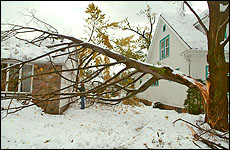Archives
Researchers to study October storm’s emergency response
By JACQUELINE GHOSEN
Reporter Contributor
UB researchers have been awarded a $30,000 grant from the National Science Foundation to study the experiences of first and second emergency responders during Western New York's "October Surprise" snowstorm.

UB
scientists will examine whether the functioning of emergency responders is
impaired significantly when they are worried about their own safety and
the safety of their families during situations like the "October Surprise"
storm.
PHOTO: DOUGLAS LEVERE
The researchers will examine a critical issue in effective disaster mitigation: whether the functioning of emergency responders is impaired significantly when they are worried about their own safety and the safety of their families.
"Our first goal is to study the effectiveness of first responders in the context of emotional pressures," said H.R. Rao, professor of management science and systems in the School of Management and principal investigator for the project. "This natural disaster provided a unique time-limited opportunity to examine and understand the differences between the different groups of first responders."
Co-investigators are Raj Sharman, assistant professor of management science and systems in the School of Management; Catherine P. Cook-Cottone, assistant professor of counseling, school and educational psychology in the Graduate School of Education; and Shambhu Upadhyaya, associate professor of computer science and engineering in the School of Engineering and Applied Sciences.
The group will work under the umbrella of UB's Center of Excellence in Information Systems Assurance Research and Education (CEISARE), which is co-directed by Upadhyaya and Rao.
Disaster planning, response and mitigation are components of UB's research focus on "extreme events," identified as one of the university's strategic strengths by the UB 2020 strategic-planning process.
Western New York's unprecedented October 2006 snowstorm resulted in extensive devastation, with major portions of the region experiencing prolonged power outages. Yet, despite the widespread problems, pockets of the region remained unaffected. This resulted in a mix of first responders, some of whom were affected by the disaster either directly or indirectly (families and significant others) and some who were not affected.
In addition to the first responders, the recovery effort was supported by second responders, such as the National Guard, which arrived days after the event.
"First responders who were personally affected by the storm will be compared with those who were not affected, as well as with the second responders, such as the National Guard, on measures including psychological distress and its effect on decision-making," Rao said.
Other goals of the project include determining how and when first responders shifted from normal incident-response patterns to disaster-level patterns and whether perceptions had changed among first responders after they experienced the unprecedented storm.
"Prior research has shown that populations that have not experienced major disasters tend to believe they are less vulnerable and better prepared than their peers in disaster-prone areas," Rao said. "However, less is known about how perceptions change if these same populations encounter a disastrous event."
The investigators expect that the information from the research will contribute to the current body of applied knowledge in the disaster-response literature and to policy implementation regarding questions of how first responders respond to, and recover from, natural disasters.
